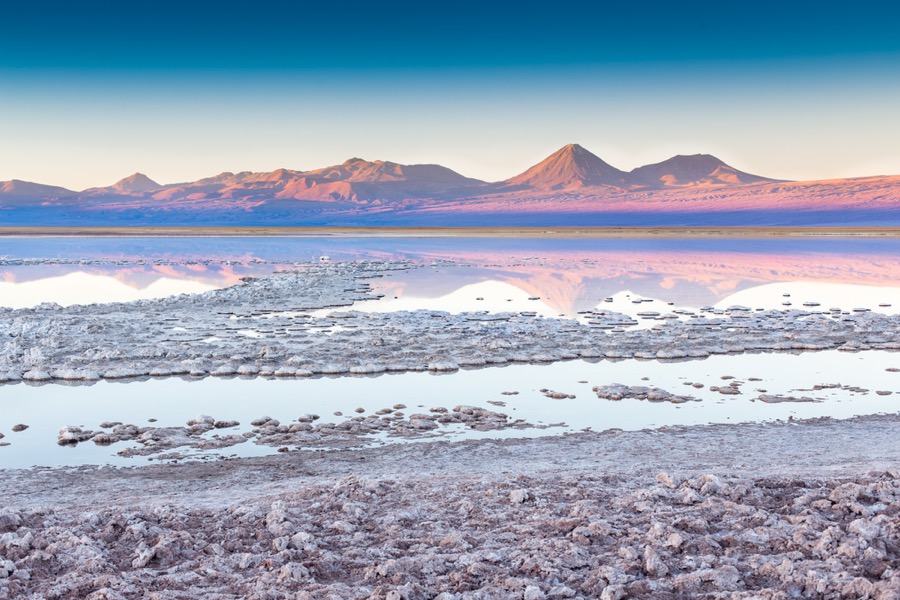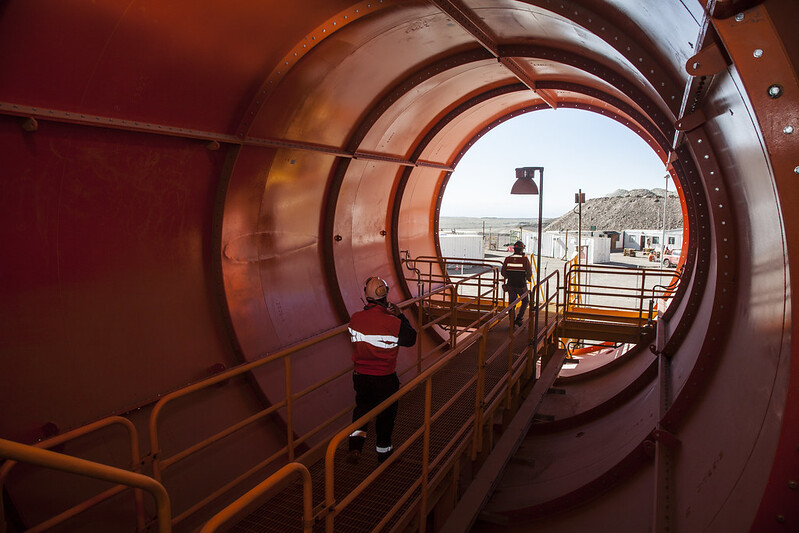Bloomberg News | August 24, 2023 
Chile holds half of the world’s most “economically extractable” reserves of lithium. (Image of the Andes Mountains reflected in a salt lake near San Pedro de Atacama, Chile, by Samuel Cohen | Shutterstock.)
Chile’s left-leaning government vowed to take a pragmatic approach to opening up new areas for lithium mining as it looks to lure investment under its public-private-participation model.

Authorities understand that “the numbers should make sense” for the private sector, Economy Minister Nicolas Grau said Thursday on a call with more than 400 lithium industry representatives from 30 countries.
Work to identify new extraction areas is well advanced as would-be bidders jostle to tap the world’s biggest reserves of the metal that’s a key component in electric-vehicle batteries. Under President Gabriel Boric’s new public-private model, the state will take a controlling stake in operations considered strategically significant, while allowing private firms to retain control of projects in non-strategic areas.
The government will be flexible when defining those categories, Grau said, acknowledging that some salt flats are too small for the state to have a major role.
“Our strategy is flexible, such that we can attract the private sector to participate,” he said.
His comments may ease lingering concerns that the new approach is a quasi-nationalization.
Read More: More than 50 firms want in on new lithium-mining model in Chile
The government has three categories of contracts. In the Salar de Atacama, the only salt flat currently being exploited, state copper behemoth Codelco is negotiating a new arrangement with SQM. Separately, Codelco and another state firm, Enami, will receive contracts in about five salt flats, for which they’ll have to find private partners. Then other groups of smaller salt flats will be open for tender to the private sector in mid 2024.
The government is “close” to specifying which salt flats will be protected and which will be available for exploitation, Grau said. Authorities will restrict lithium exploration and production on 30% of the surface area of salt flats in the country’s northern desert. That will still leave more than 10 open for development under new contracts, he said on the call.
The minister sees a “high” probability that Chile will issue at least one new contract in the next 12 months, with the government hopeful of having five new projects underway by 2025.
The government is looking to increase production after Chile saw its share of the global market decline, while shifting to more sustainable extraction methods.
It’s also looking to encourage downstream investments. Companies able to add value will have an advantage under the new model, the minister said. New contracts will also offer something similar to the current requirement to offer 25% of production for local use at preferential prices, he said.
(By James Attwood)
Chilean lawmakers to launch Codelco probe amid extended copper slide

Chile holds half of the world’s most “economically extractable” reserves of lithium. (Image of the Andes Mountains reflected in a salt lake near San Pedro de Atacama, Chile, by Samuel Cohen | Shutterstock.)
Chile’s left-leaning government vowed to take a pragmatic approach to opening up new areas for lithium mining as it looks to lure investment under its public-private-participation model.

Authorities understand that “the numbers should make sense” for the private sector, Economy Minister Nicolas Grau said Thursday on a call with more than 400 lithium industry representatives from 30 countries.
Work to identify new extraction areas is well advanced as would-be bidders jostle to tap the world’s biggest reserves of the metal that’s a key component in electric-vehicle batteries. Under President Gabriel Boric’s new public-private model, the state will take a controlling stake in operations considered strategically significant, while allowing private firms to retain control of projects in non-strategic areas.
The government will be flexible when defining those categories, Grau said, acknowledging that some salt flats are too small for the state to have a major role.
“Our strategy is flexible, such that we can attract the private sector to participate,” he said.
His comments may ease lingering concerns that the new approach is a quasi-nationalization.
Read More: More than 50 firms want in on new lithium-mining model in Chile
The government has three categories of contracts. In the Salar de Atacama, the only salt flat currently being exploited, state copper behemoth Codelco is negotiating a new arrangement with SQM. Separately, Codelco and another state firm, Enami, will receive contracts in about five salt flats, for which they’ll have to find private partners. Then other groups of smaller salt flats will be open for tender to the private sector in mid 2024.
The government is “close” to specifying which salt flats will be protected and which will be available for exploitation, Grau said. Authorities will restrict lithium exploration and production on 30% of the surface area of salt flats in the country’s northern desert. That will still leave more than 10 open for development under new contracts, he said on the call.
The minister sees a “high” probability that Chile will issue at least one new contract in the next 12 months, with the government hopeful of having five new projects underway by 2025.
The government is looking to increase production after Chile saw its share of the global market decline, while shifting to more sustainable extraction methods.
It’s also looking to encourage downstream investments. Companies able to add value will have an advantage under the new model, the minister said. New contracts will also offer something similar to the current requirement to offer 25% of production for local use at preferential prices, he said.
(By James Attwood)
Chilean lawmakers to launch Codelco probe amid extended copper slide
Reuters | August 24, 2023 |

Chuquicamata mine, Chile. Credit: Codelco.
Mining projects run by Chile’s state-owned copper producer Codelco will be investigated by a congressional committee, lawmakers in the lower house announced, amid a prolonged fall in production of the key industrial metal.

The motion to launch the investigation was approved unanimously late on Wednesday, aiming to review the administration and regulation of Codelco, the world’s largest copper miner.
The probe will focus in particular on project delays and planning, as well as Codelco’s corporate structure, according to a congressional statement.
The membership of the investigative committee has not yet been determined, and participating lawmakers will have two months to produce a report with its findings.
(By Fabian Andres Cambero)
No comments:
Post a Comment